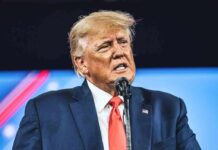President Biden has secretly shifted U.S. nuclear strategy to counter a ‘triple threat’ from Russia, China, and North Korea, sparking concerns from Beijing.
At a Glance
- Biden approved a classified nuclear strategic plan in March focusing on China’s nuclear expansion
- The plan also addresses nuclear threats from Russia and North Korea
- China expressed “grave concern” over the reported U.S. nuclear strategy shift
- The U.S. is undergoing a $1 trillion modernization of its nuclear triad
- The revised strategy, called “Nuclear Employment Guidance,” is updated approximately every four years
Biden’s Secret Nuclear Strategy Shift
In a move that has raised eyebrows internationally, President Biden has secretly updated the United States’ nuclear defense strategy to address what is being called a ‘triple threat’ from Russia, China, and North Korea. This significant shift in policy, approved in March, reflects growing concerns over the rapid advancements in nuclear technology and the aggressive geopolitical intentions of these nations.
The revised strategy, known as the “Nuclear Employment Guidance,” is a highly classified document updated approximately every four years. It aims to enhance the nation’s security by addressing the potential for simultaneous nuclear challenges from multiple adversaries. This update marks a departure from previous strategies that primarily focused on bilateral nuclear tensions.
China’s Reaction and Nuclear Capabilities
China has expressed “grave concern” over the reported U.S. nuclear strategy shift. Chinese Foreign Ministry spokesperson Mao Ning accused the U.S. of using China as a nuclear threat to avoid nuclear disarmament and expand its own arsenal. Mao emphasized that China’s nuclear arsenal is much smaller than the U.S.’s and follows a no-first-use policy focused on self-defense.
“China said it was “gravely concerned” after The New York Times reported this week that President Biden had secretly shifted the U.S. nuclear strategy to focus on countering Beijing.”
https://thehill.com/policy/defense/4841307-china-concerned-reported-us-nuclear-strategy-shift/
Despite China’s assertions, the Pentagon confirmed that China had 400 nuclear warheads in 2022, with expectations of this number tripling by 2035. This rapid expansion of China’s nuclear capabilities has been a significant factor in the U.S. strategy shift.
U.S. Nuclear Modernization and Strategic Adjustments
The United States is currently undergoing a $1 trillion modernization of its nuclear triad, including new intercontinental ballistic missiles, bomber planes, and submarines. This massive investment underscores the seriousness with which the U.S. is approaching the evolving nuclear landscape.
“The president recently issued updated nuclear-weapons employment guidance to account for multiple nuclear-armed adversaries,” – Vipin Narang, an M.I.T. nuclear strategist who served in the Pentagon
https://www.nytimes.com/2024/08/20/us/politics/biden-nuclear-china-russia.html
The updated strategy takes into account the possibility of simultaneous or sequential nuclear crises involving multiple adversaries. This shift reflects a more complex security environment, with the U.S. aiming to maintain robust defense mechanisms capable of handling various nuclear scenarios.
Global Nuclear Landscape and U.S. Response
While the U.S. and Russia still hold 90% of the world’s nuclear stockpiles, China’s rapid expansion of its nuclear arsenal has altered the global nuclear landscape. The Biden administration acknowledges the growing threat from China’s nuclear arsenal, with broad support from lawmakers for this strategic shift.
“A new nuclear age.” – Vipin Narang, acting assistant secretary of defense for space policy
https://www.csis.org/analysis/new-nuclear-age
The Pentagon’s new direction is based on assumptions of coordinated adversarial behavior, the plausibility of limited nuclear employment, and the failure of arms control efforts. However, experts caution against overestimating adversarial alliances and emphasize the need for proactive strategies to prevent the solidification of these alliances.
As the United States navigates this new nuclear age, the focus remains on maintaining a strong deterrent while working towards global stability and security. The challenges posed by this ‘triple threat’ will undoubtedly shape U.S. foreign policy and defense strategies for years to come.
Sources:
1. China ‘gravely concerned’ by reported US nuclear strategy shift
2. Biden Approved Secret Nuclear Strategy Refocusing on Chinese Threat
3. Biden revamps US nuclear deterrence posture in face of China, Russia, North Korea aggression











